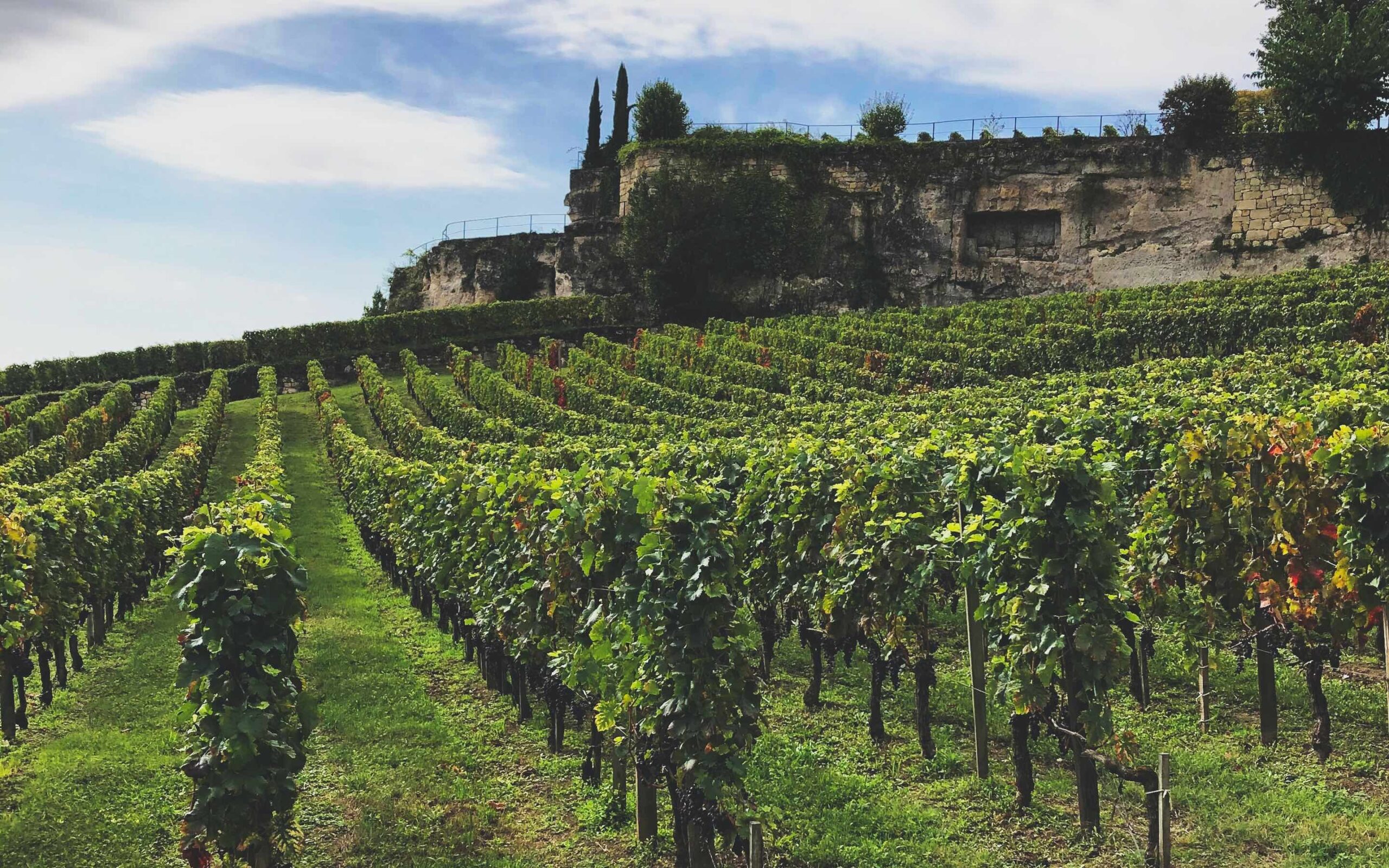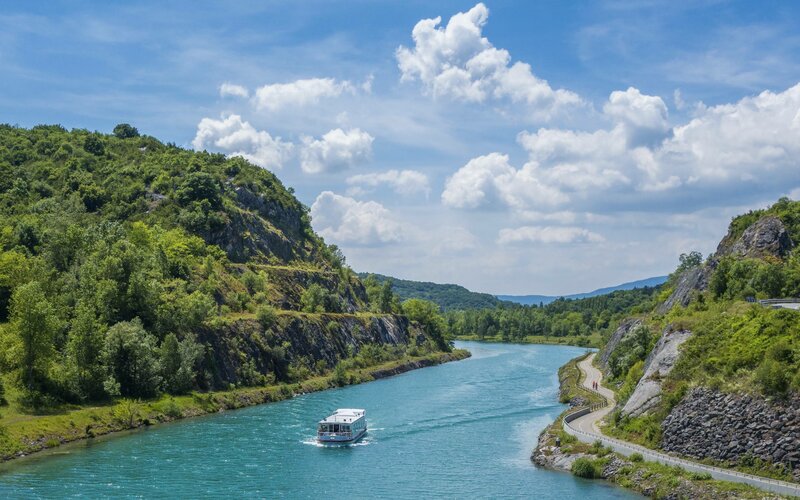
France has long been hailed for its contribution to the wine world. The Châteaux of Bordeaux, the Domaines of Burgundy and the steep vineyards of the Rhône Valley have all put France on the map. But what makes the wine from this corner of the world so special? Let’s take a look.
In this article, we’ll explore the best wine regions in France – old and new – and which grapes and bottles you can expect to find there.
Bordeaux
If you’re wondering which region in France produces the best red wines, Bordeaux is certainly one for the top of your list. This classic French wine region “is the land primarily of red wine,” as Jancis Robinson says in her BBC Maestro course, An Understanding of Wine.
The red wines of Bordeaux are mainly crafted from the esteemed Cabernet Sauvignon and Merlot grape varieties. Typically, traditional Bordeaux red wines are blends of Merlot with either Cabernet Sauvignon or Cabernet Franc, the latter being slightly lighter and more aromatic than Cabernet Sauvignon.
When exploring Bordeaux wines, you’ll often encounter the terms ‘left bank’ and ‘right bank,’ which indicate the wine’s origin on either side of the Gironde estuary.
The left bank is associated with Cabernet Sauvignon grapes, producing deeply coloured wines with robust tannins. These wines are crafted to age gracefully and are better drank when they’re young or served alongside food. Familiar names you can find from the left bank include Médoc, Graves, Pauillac, Saint-Julien, Margaux, Saint Estephe, Château Latour, Château Lafite, and Château Margaux.
The right bank benefits from a slightly cooler climate where Merlot grapes thrive. Cabernet Sauvignon grapes struggle to ripen fully here due to these cooler conditions. Blends from the right bank consist of Merlot and Cabernet Franc and generally make wines that are softer, rounder, and less tannic when young.
In addition to its red wines, Bordeaux is celebrated for producing world-class dry white wines, predominantly made from Sauvignon Blanc grapes. These wines are occasionally blended with small amounts of Sémillon grapes, which contribute some sweetness to the final produce. If it’s sweet white wine you’re after, try a Bordeaux Sauvignon Blanc.
Jancis Robinson points out in her online wine course that “it’s a large region, and it’s all about commerce.” Although it attracts wealth and fame, it also offers plenty of good value wines too, so it is possible to enjoy great quality wine without a greater price tag.

Burgundy
If it’s red wine your mind jumps to when you think of Burgundy, it’s not surprising. The region is famous for its dry red wines, made from Pinot Noir grapes. These grapes are pretty pale in colour but hold quite a robust flavour. You can also find white wines here in Burgundy too. The world-renowned Chardonnay grape thrives here and makes for dry white wines, packed with lots of savoury notes.
Burgundy has emerged as one of the most prestigious and sought-after wine regions. As a result, in recent times, there’s been a significant surge in prices for Burgundy wines. You’ll find the bottles in this part of the world are meticulously labelled, each clearly named with the grower or producer, and the specific vineyard. It’s a testament to how much focus is placed on individuality, terroir, and exclusivity.
While the heart of Burgundy is known as the Côte-d’Or, often referred to as the ‘golden slope,’ other subregions within Burgundy have also gained recognition for their winemaking practices.
Towards the north, Chablis benefits from cooler temperatures, resulting in wines that are firmer and more acidic. You’ll find Chablis wines come in four different quality levels. From the lower end of the scale to the upper are Petit Chablis (made on the outskirts of the region), Chablis (better consumed when young), Chablis Premier Cru (usually a trusted buy), and a Chablis Grand Cru (known to offer longevity).
Moving southwards, the Côte Chalonnaise and the Mâconnais experience warmer climates, so wines in these regions are richer and more rounded in taste and texture. Try a red wine from Givry or Mercurey or a 2021 Mâconnais white wine for something special.
Champagne
This famous region is home to one famous fine wine – Champagne. Light, bubbly, and brimming with sophistication, it’s a drink that marks special occasions in homes and at events across the world.
So, what makes Champagne different from other sparkling wines? The short answer is that sparkling wine can only be named ‘Champagne’ if it is made in this prestigious region. It’s also made differently from many sparkling wines, using what’s known as the ‘traditional method’ or ‘méthode champenoise.’ This technique involves a second fermentation that occurs in the bottle and results in delicate bubbles and a more complex flavour.
“Champagne does not regard itself as a sparkling wine. It regards itself as Champagne,” says Jancis Robinson in her BBC Maestro course. It’s a serious debate too. “It has a team of lawyers dedicated to protecting the name of Champagne.”
If you’re wondering what it is that makes the region so special, it can be partly attributed to its good grape-growing conditions and its longstanding relationship with sparkling wine.
A significant proportion of the region contains chalky soils, which are well-suited for cultivating the specific grape varieties used in Champagne production, namely Chardonnay, Pinot Noir, and Pinot Meunier. The northern location of Champagne allows for cooler temperatures, which are crucial in preserving the acidity and delicate flavours of the grapes.
The region has long been known for its sparkling wine production, which gave it quite the advantage when it came to defining itself as the wine of celebration and bringing it the luxury and exclusivity it sees today.

Rhône Valley
Home to one of France’s greatest rivers is the Rhône Valley. The famous River Rhône flows throughout this region, connecting the north and south, which both have contrasting climates.
In northern Rhône, vineyards on steep slopes endure harsh winters and warmer summers. The notable Syrah grape can be found thriving here, which produces very dry and palatable red wines. It’s not uncommon to find good white wine grape mixtures here too, but red wines are more prominent.
A Mediterranean climate prevails in the southern region. And it’s here where the Grenache grape dominates. Wines in the Southern region of the Rhône are blends of various grapes like Grenache, Syrah, and Mourvèdre and offer richer and warmer tastes than those in the North. Because of the hotter climate, you’ll notice wines here may have higher alcohol content. So as Jancis Robinson advises in her online wine course, check the labels when buying wines from the south, such as Cote du Rhône or Châteauneuf-du-Pape.
Provence
For those wondering which wine region in France is known for its rosé wine, look no further than Provence. In recent years, the rosé wines from this region have gained significant popularity both in France and internationally.
Provence benefits from a Mediterranean climate with warm, sunny days and cooling mistral winds. The primary grape varieties here include Grenache, Syrah, Mourvèdre, Cinsault, and Rolle (Vermentino). Provence rosés are typically dry, crisp, and refreshing and have delicate flavours with a pale pink colour.
Lesser-known French wine regions
If you’re looking to try something a little different, here are a few other wine regions of France well worth exploring.

Languedoc-Roussillon
Located in the southern part of France, Languedoc-Roussillon has experienced a resurgence in recent years.
As one of France’s largest wine regions, it too offers a diverse range of wines. The region benefits from ample sunshine and a Mediterranean climate, allowing for the cultivation of a wide variety of grapes. Languedoc-Roussillon produces both red and white wines, with notable varieties including Grenache, Syrah, Carignan, and Viognier. The region’s wines are often praised for their value and quality, offering premium options at various price points.
Alsace
Alsace, located in the north-eastern part of France, is known for its cool climate, which has traditionally been favourable for growing grapes used in high-quality white wines. In recent years, Alsace has seen the emergence of several trendy wines that have gained popularity among wine enthusiasts. Crémant d’Alsace, Alsace Dry Reisling, Alsace Grand Cru, and orange wines are a few examples.
Loire Valley
While it has a long history of winemaking, the Loire Valley has gained increasing recognition in recent years for its exceptional wines and diverse range of grape varieties.
The Loire Valley is known for its white wines, particularly those made from Sauvignon Blanc, Chenin Blanc, and Melon de Bourgogne grapes. It is also celebrated for producing delightful sparkling wines, such as Crémant de Loire.
If you’re a red wine drinker, try one of the region’s famous reds – a Chinon, a Bourgueil, or a St-Nicolas de Bourgueil. If it’s white wine that calls to your palate, try a Savennières, a Touraine Vouvray, or a Muscadet.
It’s no surprise French wine has won the custom of wine drinkers all over the world. A nation steeped in winemaking heritage and invested in futureproofing, it’s well worth keeping an eye on how its practices and its produce may change in the future.
If you’re keen to learn more about the wine region’s of the world, take a look at our guide to wine regions of the world. And if you want to dive deeper, take a look at Master of Wine, Jancis Robinson’s BBC Maestro course. In it, Jancis sheds light on the entire process from grape to glass. Tasting, pairing, picking the right bottle, and cracking some of the most common wine myths – there’s a lot to learn…

Give the gift of knowledge
Surprise a special someone with a year's access to BBC Maestro or gift them a single course.





